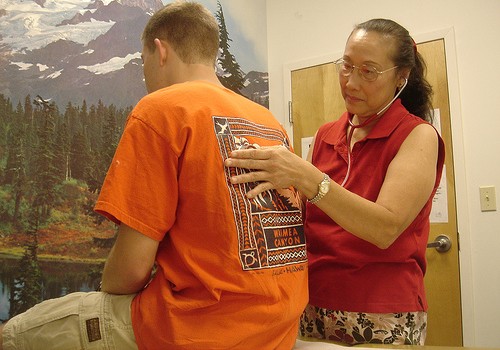
What Is COPD?
Chronic Obstructive Pulmonary Disease (COPD) consists of two closely-related clinical entities: 1. Chronic bronchitis is a chronic inflammation of the large airways characterized by a cough and sputum most days during three months of two successive years, and 2. Emphysema, a loss of the elastic recoil of the lungs and histologically, an enlargement of the airways smaller than terminal bronchioles and the destruction of the alveoli's walls. Patients may either have asthma or COPD, but not both. If the patient is above 35 years of age, has a history of smoking, a history of sputum production, a cough, shortness of breath without clear variations throughout the day, COPD is likely. NICE (the Birtish National Institute for Healthcare Excellence) recommends the name COPD for this disease.
- Important notification about information and brand names used in this slideshow!
- Photo courtesy of Amy Watson by Flickr : www.flickr.com/photos/pandaposse/209996491/
- Clinical Medicine y Kumar and Clark
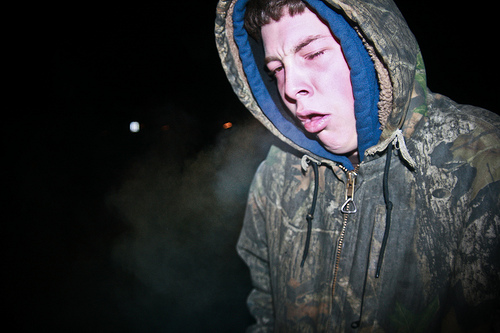
COPD Isn't A Rare Illness
Around 329 million patients with Chronic Obstructive Pulmonary Disease were known to exist in 2010. There has been a sharp rise in the prevalence of COPD since 2004, when around 64 million patients were affected by it globally. This rise can be directly attributed to an increase in smoking. It occurs more commonly in male than females. In England and Wales, about 25000 deaths are caused by COPD and its complications. Globally, COPD related deaths stand at around three million. This makes it the fourth leading cause of death.
- Important notification about information and brand names used in this slideshow!
- Photo courtesy of r.f.m II by Flickr : www.flickr.com/photos/robhardingii/5403822840/
- Clinical Medicine by Kumar and Clark

Not Only Smokers Are Affected
Smoking is the main risk factor for COPD. The tendency to develop COPD rises with the number of cigarettes smoked and all life-long smokers get COPD. Individuals who work in gold mines, coal mines, textile plants, and other hazardous workplaces may also get COPD due to the chemicals and dust exposure that caused an elevated state of reactivity in the airways. Similar to cigarette smoke, these molecules increase airway secretions and cause constriction of the airways. Hereditary factors may also play a role in the development of COPD. Some schools hypothesize that COPD has an autoimmune component as well. They theorize that the reason for COPD getting worse even after cessation of smoking is due to a breakdown in self-tolerance.
- Important notification about information and brand names used in this slideshow!
- Photo courtesy of Bahi by Flickr : www.flickr.com/photos/bahi_p/287138691/
- Clinical Medicine by Kumar and Clark
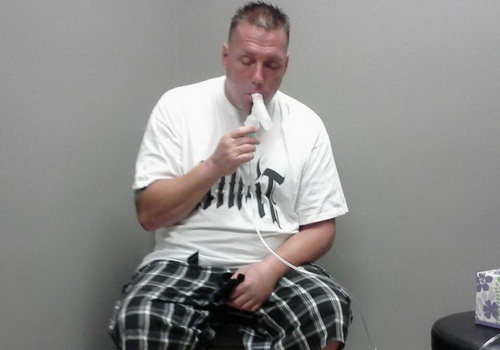
Shortness Of Breath Is The Main Symptom
Shortness of breath, an increased effort required to inhale and exhale, using the accessory muscle of respiration, an enlarged barrel shaped chest, exhalation through pursed lips, prolonged exhalation, a cough, and sputum production are common clinical features of COPD. Pink puffers and blue bloaters are names coined to identify two ends of a spectrum of COPD patients. Pink puffers have a good ventilation of the alveoli, nearly normal oxygen pressures and low/normal carbon dioxide pressures in their blood. They are not cyanosed (bluish discoloration of lips). Blue bloaters, on the other hand, have a poor ventilation of the alveoli and low oxygen pressures in their blood. They may develop heart failure as a result of COPD (heart failure will cause body swelling).
- Important notification about information and brand names used in this slideshow!
- Photo courtesy of Danlorenz87 by Photobucket : media.photobucket.com/user/Danlorenz87/media/Facebook/Photos%20of%20Me/474392_423241581031434_1824164009_o.jpg.html?filters[term]=heavy%20breathing&filters[primary]=images&sort=1&o=54
- Clinical Medicine by Kumar and Clark

COPD Doesn't Affect Only Your Lungs
COPD is a lung disease. It can be aggravated by cold weather, smoking, infections and allergic reactions. This is known as an acute exacerbation. An enlargement of the small airways can progress to a stage where small enclosed collections of air (bullae) form. These bullae may rupture and then air enters the space between the lung and the chest wall (pneumothorax). Smoking causes lung cancer. so COPD and lung cancer can co-exist. Chronically low levels of oxygen in the blood cause bone marrow to form more hemoglobin (oxygen transporter in blood) to ensure normal levels of oxygen get to peripheral tissues. This is known as polycythemia. Severe polycythemia may lead to a need for blood to be extracted to reduce shortness of breath. Because of a long-term injury to lung tissue a rise in blood pressure in the lung vessels (elevated pulmonary pressures) may occur. This causes a strain on the heart's right ventricle and atrium. In severe cases right heart failure can occur (cor pulmonale).
- Important notification about information and brand names used in this slideshow!
- Photo courtesy of Abigail Toribio by Flickr : www.flickr.com/photos/simplyabbey/5870037168/
- Clinical Medicine by Kumar and Clark

What Happens In Lungs With COPD?
Smoking releases toxic oxygen particles (free radicals) which are harmful to airway cells. Various toxins in cigarette smoke injure the lining of the airways and these cells release cytokines. Cigarette smoke impairs the protective enzymes which prevent protease injury to lungs. Due to the destruction of the walls of the alveoli, the elastic recoil of the lung is lost. The air remains trapped inside the alveoli and alveolar pressures rise. This tends to compress the airways, making it difficult to breathe out and it slows down the process of emptying the lungs. Patients may purse their lips to increase the pressure gradient across the lungs to make it easier to breath. The injury to he lining of the airways, causes secretions to increase, further reducing the already low air flow.
- Important notification about information and brand names used in this slideshow!
- Photo courtesy of coldpants by Flickr : www.flickr.com/photos/auuep/2202648864/
- Clinical Medicine by Kumar and Clark
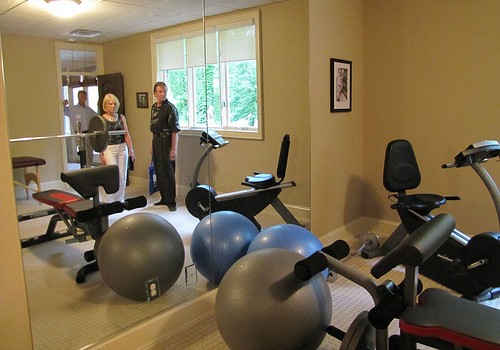
Tests To Assess And Diagnose COPD
Spirometry is used to assess a patient's lung function and to confirm the diagnosis of COPD. During the spirometry, the patient is asked to breathe in deeply and exhale as much as possible as fast as possible through a tube-like sensor. Forced inspiratory volume, forced vital capacity (maximum volume of air breathed out during the whole expiration process — FVC) and forced expiratory volume for one second (maximum volume of air breathed out during the first second of expiration — FEV1) are measured. COPD is diagnosed when the FEV1 and FVC tests are less than 0.7. The severity of COPD is determined in accordance with the GOLD scale. A chest X-ray may show a narrow mediastinum, over-inflated lungs, a flat diaphragm and bullae. The arterial blood gas may show poor oxygen partial pressure.
- Important notification about information and brand names used in this slideshow!
- Photo courtesy of Clarkston SCAMP by Flickr : www.flickr.com/photos/clarkstonscamp/4679816931/
- Clinical Medicine by Kumar And Clark
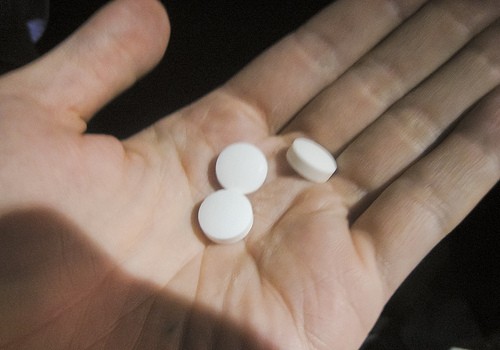
Treating COPD
There is no cure for COPD, so treatment focuses on management. Acute exacerbations are treated at emergency units with bronchodilators, steroids and antibiotics. Drugs that dilate the airways offer relief. Salbutamol, terbutalin, salmetrol and ipratropium are some examples of inhalators patients may be prescribed. Steroids reduce the airways' reaction to inhaled harmful agents such as cigarette smoke. This reduces the airways' secretions. Beclomethasone and hydrocortisone are two commonly used steroids. Oxygen is given with caution in patients with COPD. The patient will have suffered from low oxygen levels in the blood for a long time, and the chemical sensors in the brain drive respiration continually because it senses a low level. When high-flow oxygen is given via a mask, the blood oxygen levels rise and the signal telling the brain to continue breathing will suddenly stop, causing respiratory arrest. Oxygen saturation is maintained in the low 90s for this reason.
- Important notification about information and brand names used in this slideshow!
- Photo courtesy of Russell Bernice by Flickr : www.flickr.com/photos/russellbernice/4956469660/
- Clinical Medicine by Kumar and Clark

Lifestyle Changes That Would Be Beneficial
COPD patients definitely need to stop smoking. You may need professional help to achieve this. Breathing exercises to strengthen the respiratory muscles and regular low intensity physical exercise are essential as well. Individuals who are regularly exposed to dust or allergens in their workplace may need to either change their job or take extra precautions to avoid regular exposure. There is also a diet suitable for COPD patients. This COPD diet is very important because the extra effort patients need to breathe demands additional caloric intake. If the patient’s body mass index is below normal, the dietary caloric intake can be safely increased. In obese individuals, the caloric intake needs to be balanced with regular exercise.
- Important notification about information and brand names used in this slideshow!
- Photo courtesy of SalFalko by Flickr : www.flickr.com/photos/safari_vacation/6055437609/
- Clinical Medicine by Kumar and Clark
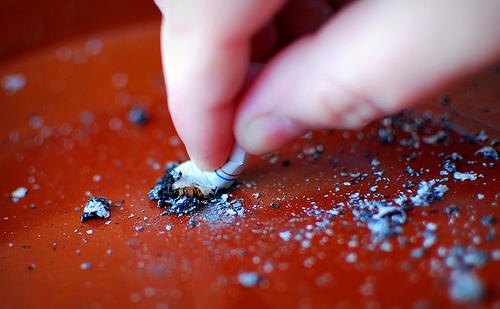
Preventing COPD
Primary prevention (modifying risk factors to avoid getting the disease) entails limiting exposure to cigarette smoke, dust and other harmful agents. Family members with COPD need to take extra care. In cases of nicotine addiction, you could use nicotine patches or chewing gums instead. Governments can actively participate in disease prevention at a national level. Limiting air pollution, implementing strict safety regulations to prevent occupational exposure and limiting cigarette smoking with necessary legislature will reduce the prevalence of COPD. Secondary prevention includes treating allergic reactions, acute exacerbations and limiting the disease progression to avoid developing complications of the disease.
- Important notification about information and brand names used in this slideshow!
- Photo courtesy of Morgan by Flickr : www.flickr.com/photos/meddygarnet/4170136164/
- Clinical Medicine by Kumar and Clark




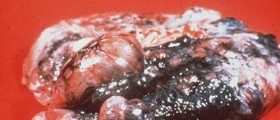

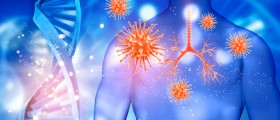




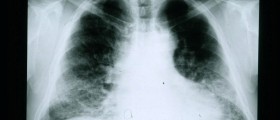




,-Asthma-And-Anxiety_f_280x120.jpg)


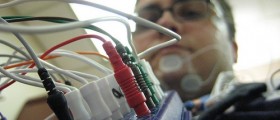







Your thoughts on this
Loading...